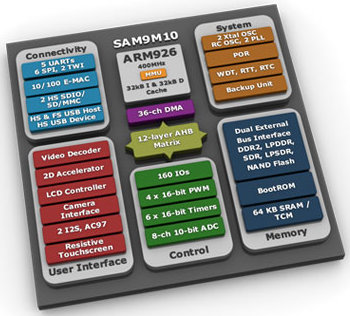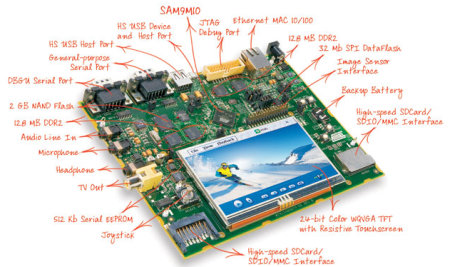Atmel’s SAM9 processors gain Android port
Jun 1, 2011 — by Eric Brown — from the LinuxDevices Archive — 15 viewsAtmel Corp. announced that its popular ARM9-based SAM9G45 and SAM9M10 system on chips (SoCs) are now compatible with Android 2.1. Atmel also announced the availability of an Android board support package (BSP) for Atmel's SAM9M10-G45-EK boards, and Mentor Graphics is helping to provide optional vertically focused GUIs for the BSP.
Applications for the Android-supported SAM9G45 and SAM9M10 processors include household appliances, industrial equipment monitors, and medical devices, says Atmel. The Android port and BSPs are built on top of the Linux kernel with libraries for audio and graphics, application framework, and browser and multimedia applications, says the company.
The Atmel port is based on Android 2.1 and supports a camera interface and software decoding, says the company. Web browsing is said to be supported via an Ethernet cable or a Wi-Fi SDIO dongle from Atmel partner H&D Wireless. The Android port also supports hardware video decoding on the video-enhanced SAM9M10 SoC.
Atmel says it is collaborating with companies including Mentor Graphics to provide optional, ready-to-use GUI's (graphical user interfaces) for embedded applications in vertical markets. Mentor Graphics –which has done Linux- and Android related development work for MIPS, Freescale, Texas Instruments, and others — will offer its "drag and drop" Inflexion UI tool to the BSP.
Originally announced for Mentor Graphics' Nucleus operating system in 2007, Inflexion has since been introduced in a Linux version that was used, for example, in Freescale's i.MX53 Quick Start board for Linux and Android.

SAM9M10 architecture
Atmel's Linux-ready SAM9G45 and SAM9M10 processors, announced in July 2009 and January 201 respectively, are built on 400MHz ARM929EJ cores. The two processors form the basis for Atmel's latest SAM9G46 and SAM9M11 microcontrollers, respectively. Announced in April 2010, the latter two chips add support for 256-bit AES, triple DES, and SHA encryption.
The SAM9M10 is pin-compatible with the SAM9G45, and similarly integrates twin parallel external bus interfaces (EBI) to support DDR2 memory at 133MHz. The SoC similarly integrates high-speed (480Mbps) USB host and device ports with on-chip transceivers, says Atmel.
Both SoCs offer Ethernet MAC, high-speed SD/SDIO/MMC interfaces, an LCD controller with resistive touchscreen support, and CMOS camera and audio interfaces. They are said to support either 1.8 or 3.3 Volt I/O supply voltage.
The SAM9M10 builds on the SAM9G45's base by adding a video decoder, said to decode video streams at up to D1 (720 x 576), or WVGA (800 x 480) at 30 frames per second (fps). Supporting H264, H263, MPEG4, MPEG2, VC1, and JPEG formats, the SAM9M10 also includes 2D graphics acceleration, image scaling and image rotation, color space conversion (YUV to RGB), and picture-in-picture capability, according to Atmel.
SAM9M10-EK evaluation kit
Atmel's SAM9M10-EK kit, pictured below, appears to be identical to its earlier SAM9G45-EK board except for the inclusion of the newer SoC. The boards offer two banks of 128MB DDR2 memory, each connected to an external bus interface, as well as 2GB of NAND, and 32MB (2M x 16) of flash memory. Dual high-speed SD/SDIO/MMC slots are also said to be supplied.

SAM9M10-EK evaluation board
(Click to enlarge)

SAM9M10-EK (detail)
(Click to enlarge)
Availability
The Android BSPs for Atmel's SAM9M10-G45-EK boards appears to be available now. More information may be found at Atmel's ARM-based solutions site.
This article was originally published on LinuxDevices.com and has been donated to the open source community by QuinStreet Inc. Please visit LinuxToday.com for up-to-date news and articles about Linux and open source.